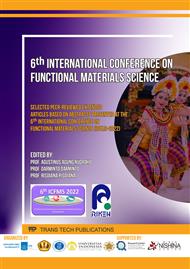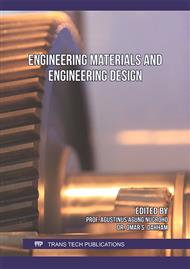[1]
Subramanian R, Murugan P, Chinnadurai G, et al. MaterResExpress (2020) 7: 1–8.
Google Scholar
[2]
DileepKumar VG, Sridhar MS, Aramwit P, et al. Journal of Biomaterials Science, Polymer Edition (2022) 33: 229–261.
Google Scholar
[3]
Farias KAS, Sousa WJB, Cardoso MJB, et al. Ceramica (2019) 65: 99–106.
Google Scholar
[4]
Hare PO, Meenan BJ, Burke GA, et al. Biomaterials (2010) 31: 515–522.
Google Scholar
[5]
Yelten-yilmaz A, Yilmaz S. Ceramics International (2018) 44: 9703–9710.
DOI: 10.1016/j.ceramint.2018.02.201
Google Scholar
[6]
Hosseini B, Mirhadi SM, Mehrazin M, et al. Trauma Mon (2017) 22 (5): 1–7.
Google Scholar
[7]
Odusote JK, Danyuo Y, Baruwa AD, et al. Journal of Applied Biomaterials & Functional Materials. (2019).
Google Scholar
[8]
Ofudje EA, Rajendran A, Adeogun AI, et al. Advanced Powder Technology (2017) 29: 1–8.
Google Scholar
[9]
Barua E, Deoghare AB, Deb P, et al. Materials Today: Proceedings (2019) 15: 188–198.
Google Scholar
[10]
M Sirait, K Sinullingga RSDS. Journal of Physics; 1462. Epub ahead of print (2020).
Google Scholar
[11]
Hartatiek, Yudyanto, R Kurniawan M. Mater Sci Eng; 515. Epub ahead of print (2019).
Google Scholar
[12]
Poinern GE, Brundavanam RK, Mondinos N, et al. Ultrasonics - Sonochemistry (2009) 16: 469–474.
DOI: 10.1016/j.ultsonch.2009.01.007
Google Scholar
[13]
Cai Z, Wang X, Zhang Z, et al. Royal Society of Chemistry (2019) 9: 13623–13630.
Google Scholar
[14]
Chen J, Liu J, Deng H, et al. Ceramics International (2019) 46: 2185–2193.
Google Scholar
[15]
Singh G, Kapurthala M. Journal of Minerals & Materials Characterization & Engineering (2011); 8, no. 8: 727–734.
Google Scholar
[16]
Faksawat K, Sujinnapram S, Limsuwan P, et al. AMR (2015) 1125: 421–425.
Google Scholar
[17]
Kong D, Xiao X, Qiu X, et al. Functional Materials Letters (2015) 8: 3–6.
Google Scholar
[18]
Yousefpour M, Taherian Z. Superlattices and Microstructures (2013) 54: 78–86.
Google Scholar
[19]
Tang H, Liu D, Bi Y. Epub ahead of print (2018).
Google Scholar
[20]
Marzieh Jalilpour. Int J Phys Sci; 7.
Google Scholar
[21]
Gopi D, Shinyjoy E, Kavitha L. Spectrochimica Acta Part A: Molecular and Biomolecular Spectroscopy (2014) 127: 286–291.
DOI: 10.1016/j.saa.2014.02.057
Google Scholar
[22]
Saranya S, Samuel Justin SJ, Vijay Solomon R, et al. Physicochemical and Engineering Aspects (2018) 538: 270–279.
DOI: 10.1016/j.colsurfa.2017.11.012
Google Scholar
[23]
Yoruç ABH, İpek Y. Acta Phisica Polonica (2012) 121: 230–232.
Google Scholar
[24]
Yoruç ABi̇H, Koca Y. Digest Journal of Nanomaterials and Biostructure (2009) 4: 73–81.
Google Scholar
[25]
Chandrasekar A, Sagadevan S, Dakshnamoorthy A. International Journal of Physical Sciences; 8. (2013)
Google Scholar
[26]
V.J Ingola, K.H Hussein AAK. Journal of Biomedical material research (2017) 105: 2935–2947.
Google Scholar
[27]
Groot K De. Bioceramics of Calcium Phosphate. CRC Press, (2018)
Google Scholar
[28]
Cai Z, Wang X, Zhang Z, et al. Royal Society of Chemistry Advances (2019) 13623–13630.
Google Scholar
[29]
Andrea J, Hermann-muñoz JA, Id ALG, et al. MDPI (2018) 11: 333.
Google Scholar
[30]
Fathi MH, Hanifi A. Advances in Applied Ceramics (2009) 108: 363–368.
Google Scholar
[31]
Pitt K, Peña R, Tew JD, et al. Powder Technology (2018) 326: 327–343.
Google Scholar
[32]
Hajar Saharudin S, Haslinda Shariffuddin J, Ida Amalina Ahamad Nordin N, et al. Materials Today (2019) 19: 1208–1215.
DOI: 10.1016/j.matpr.2019.11.124
Google Scholar
[33]
Brundavanam R, Le XT, Djordjevic S, et al. International Journal of Nanomedicine (2011) 6: 2083–2095.
Google Scholar
[34]
Brundavanam RK, Eddy G, Poinern J, et al. American Journal of Materials Science (2013) 3: 84–90.
Google Scholar
[35]
Cunniffe M, Brien FJO, Partap S, et al. J of Biomedical Materials Research A (2010) 95A: 1142–1149.
Google Scholar
[36]
Kim H-M, Himeno T, Kokubo T, et al. Biomaterials (2005) 26: 4366–4373.
Google Scholar
[37]
Hannink G, Arts JJC. (2011) 42: S22–S25.
Google Scholar



